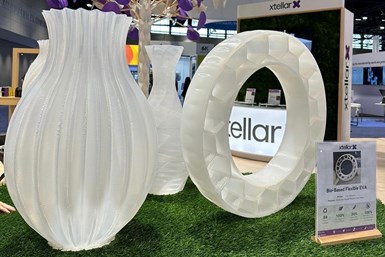Xtellar Offers Flexible Bio-Based EVA Pellets for Large Format 3D Printing
Bio-based flexible EVA (Ethylene Vinyl Acetate) pellets offer sustainable, lightweight, flexible capabilities for large-format additive manufacturing.
Bio-based EVA materials debuted at RAPID + TCT 2023 in Xtellar’s first exhibition booth. Photo Credit: Xtellar
3D printing materials provider Xtellar says its bio-based EVA pellets bring flexibility and sustainability to a variety of pellet-compatible, large-format 3D printers. EVA is a clear, hygroscopic, amorphous elastomeric material with bio-based formulation sourced from sustainable raw sugar cane feedstock.
Xtellar was established in 2023 by combining the Braskem 3D materials division and Taulman3D, enabling increased flexibility to accelerate additive manufacturing innovation through strategic partnerships and new growth channels.
The company says its range of bio-based polymers for 3D printing offers the next evolution in sustainable solutions for additive manufacturing (AM). Sourced from sustainable raw sugar cane feedstock sources, these eco-friendly materials have a lower carbon footprint than traditional fossil fuel-based materials. The company says the bio-based 3D printing pellets are in a class of their own regarding sustainability, quality and functionality.
“Bringing a wider variety of sustainable material options to 3D printing is one of Xtellar’s core missions,” says Jason Vagnozzi, Xtellar CEO. “In 2022, we launched the industry’s first bio-based polyethylene and flexible EVA 3D printing filaments, and this year we continue our mission by launching the first bio-based flexible EVA pellets specifically formulated for large-format 3D printing applications,”
Xtellar says its bio-based EVA pellets are the industry’s first sustainable flexible material derived from raw sugar cane. This formulation is said to provide a sustainable alternative to traditional flexible TPE and TPU materials currently available on the market. The eco-friendly formulation delivers a combination of sustainability, flexibility, ductility, lightweighting and moisture resistance — in pellet form.
“This material is an excellent sustainable alternative to many traditional TPU materials currently used for additive manufacturing and reaffirms our commitment to a more circular, carbon-neutral future,” Vagnozzi says. “We couldn’t be more excited about this latest addition to our product portfolio and will continue to innovate more sustainable options to meet our clients’ growing needs for more sustainable 3D material alternatives.”
- Watch this video to hear the AM team discuss Xtellar’s EVA during at RAPID+TCT 2023. During the event, Xtellar introduced its pellet form of ethylene vinyl acetate (EVA) suitable for extrusion-style 3D printers. Stephanie Hendrixson reports on the bio-based, sustainable material derived from sugarcane, which is offered as an alternative to TPU and other flexible polymers.
Related Content
-
Multimodal Powders Bring Uniform Layers, Downstream Benefits for Metal Additive Manufacturing
A blend of particle sizes is the key to Uniformity Labs’ powders for 3D printing. The multimodal materials make greater use of the output from gas atomization while bringing productivity advantages to laser powder bed fusion and, increasingly, binder jetting.
-
Sustainable Furniture Company Model No. Maintains Product Focus with Switch from DIY to Industrial 3D Printers
The startup founded in 2018 has matured in its product offerings as well as its manufacturing equipment, moving from homegrown 3D printers to industrial large-format machines.
-
Video: A Mechanical Method for Metal Powder Production
Metal Powder Works has developed a method for producing powders from solid barstock, no melting required. This video covers how the process works and benefits of mechanical production of powders.















